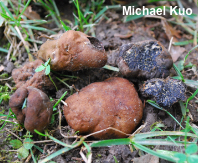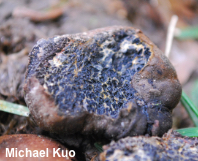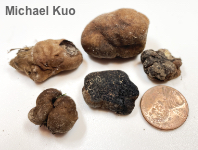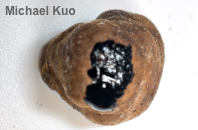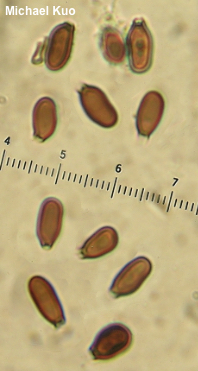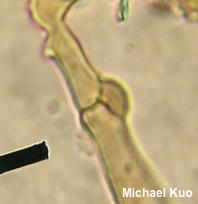| Major Groups > Truffles & False Truffles > Melanogaster broomeanus |

|
Melanogaster broomeanus [ Basidiomycota > Boletales > Paxillaceae > Melanogaster . . . ] by Michael Kuo One of several false truffles in the genus Melanogaster, this species is mycorrhizal with hardwoods, often appearing in disturbed-ground settings. Like other species in the genus, Melanogaster broomeanus produces lumpy, roundish fruiting bodies that are partially submerged in the ground and, when sliced open, feature interiors with slimy black pockets separated by thin walls. Since species of Melanogaster all look more or less the same on casual inspection, reference to their mycorrhizal associations and microscopic features is probably required for identification; Melanogaster broomeanus can be separated on the basis of its hardwood association and its comparatively small, tick-shaped spores. Other species, like Melanogaster tuberiformis and Melanogaster ambiguus, are associated with conifers or have differently shaped, larger spores. Only Melanogaster variegatus also combines hardwood association with small spores, but its spores are slightly skinnier and ellipsoid, rather than tick-shaped. Thanks to Gordon Tucker for steering me towards a collection of Melanogaster broomeanus. Description: Ecology: Mycorrhizal with a variety of hardwoods; growing gregariously, often in disturbed-ground settings (roadsides, gardens, urban locations); summer and fall; originally described from England and France; widespread in Europe; in the United States reported from the West Coast to Texas and the Midwest. The illustrated and described collection is from Illinois. Fruiting Body: 2–4.5 cm across; 1.5–3 cm high; irregularly round and lumpy. Outer surface at first yellowish but soon brown to dark brown; bald to the naked eye but with a sub-felty texture when rubbed. Interior chambered with pockets of dark gray to black between thin, whitish to yellowish walls; hard; becoming thinly slimy with development. Odor: Sweet and thick; nutty; strong. Chemical Reactions: KOH on outer surface instantly black. Spore Print: Not obtainable. Microscopic Features: Spores 6–9 x 3–5 µm; subellipsoid to subcylindric, shaped like elongated ticks, with one end slightly truncated; often with sterigmal attachments adhering; thick-walled; reddish brown in KOH. Hyphae of the peridium 3–8 (–10) µm thick; smooth; walls under 0.5 µm thick; reddish brown in KOH; with clamp connections. REFERENCES: M. J. Berkeley, 1843. (Miller, n. d..; Zeller & Dodge, 1936; Hawker, 1954; Breitenbach & Kränzlin, 1986; Huffman et al., 2008; Buczacki et al., 2013; Uzun et al., 2014; Lacheva, 2015; Türkoglu et al., 2015; López et al., 2016; Kaygusuz et al., 2018; Knudsen, 2018; Læssøe & Petersen, 2019.) Herb. Kuo 10182103, 10192101. This site contains no information about the edibility or toxicity of mushrooms. |
© MushroomExpert.Com |
|
Cite this page as: Kuo, M. (2021, October). Melanogaster broomeanus. Retrieved from the MushroomExpert.Com Web site: http://www.mushroomexpert.com/melanogaster_broomeanus.html |
